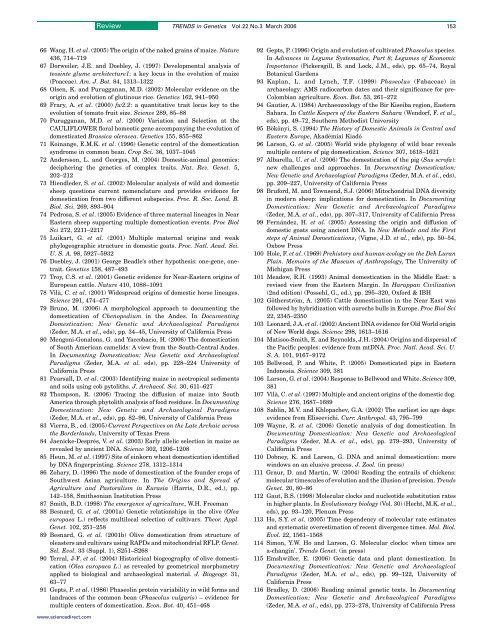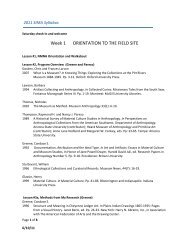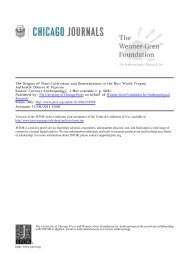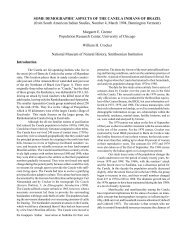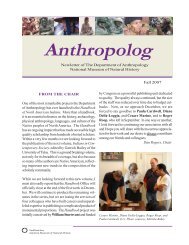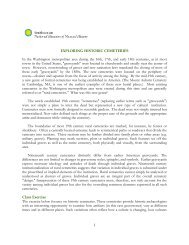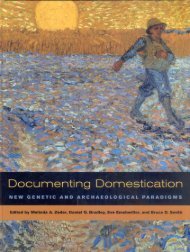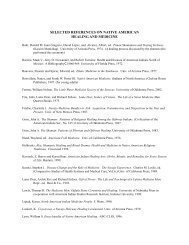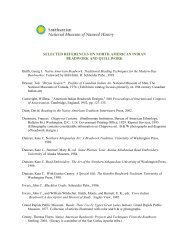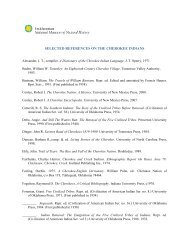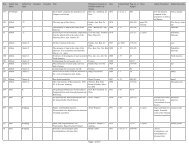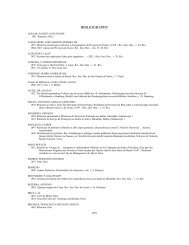Zeder, Melinda A, Emshwiller, Eve, Smith, Bruce D. - Anthropology ...
Zeder, Melinda A, Emshwiller, Eve, Smith, Bruce D. - Anthropology ...
Zeder, Melinda A, Emshwiller, Eve, Smith, Bruce D. - Anthropology ...
You also want an ePaper? Increase the reach of your titles
YUMPU automatically turns print PDFs into web optimized ePapers that Google loves.
66 Wang, H. et al. (2005) The origin of the naked grains of maize. Nature<br />
436, 714–719<br />
67 Dorweiler, J.E. and Doebley, J. (1997) Developmental analysis of<br />
teosinte glume architecture1: a key locus in the evolution of maize<br />
(Poaceae). Am. J. Bot. 84, 1313–1322<br />
68 Olsen, K. and Purugganan, M.D. (2002) Molecular evidence on the<br />
origin and evolution of glutinous rice. Genetics 162, 941–950<br />
69 Frary, A. et al. (2000) fw2.2: a quantitative trait locus key to the<br />
evolution of tomato fruit size. Science 289, 85–88<br />
70 Purugganan, M.D. et al. (2000) Variation and Selection at the<br />
CAULIFLOWER floral homeotic gene accompanying the evolution of<br />
domesticated Brassica oleracea. Genetics 155, 855–862<br />
71 Koinange, E.M.K. et al. (1996) Genetic control of the domestication<br />
syndrome in common bean. Crop Sci. 36, 1037–1045<br />
72 Andersson, L. and Georges, M. (2004) Domestic-animal genomics:<br />
deciphering the genetics of complex traits. Nat. Rev. Genet. 5,<br />
202–212<br />
73 Hiendleder, S. et al. (2002) Molecular analysis of wild and domestic<br />
sheep questions current nomenclature and provides evidence for<br />
domestication from two different subspecies. Proc. R. Soc. Lond. B.<br />
Biol. Sci. 269, 893–904<br />
74 Pedrosa, S. et al. (2005) Evidence of three maternal lineages in Near<br />
Eastern sheep supporting multiple domestication events. Proc Biol<br />
Sci 272, 2211–2217<br />
75 Luikart, G. et al. (2001) Multiple maternal origins and weak<br />
phylogeographic structure in domestic goats. Proc. Natl. Acad. Sci.<br />
U. S. A. 98, 5927–5932<br />
76 Doebley, J. (2001) George Beadle’s other hypothesis: one-gene, onetrait.<br />
Genetics 158, 487–493<br />
77 Troy, C.S. et al. (2001) Genetic evidence for Near-Eastern origins of<br />
European cattle. Nature 410, 1088–1091<br />
78 Vilà, C.et al. (2001) Widespread origins of domestic horse lineages.<br />
Science 291, 474–477<br />
79 Bruno, M. (2006) A morphological approach to documenting the<br />
domestication of Chenopodium in the Andes. In Documenting<br />
Domestication: New Genetic and Archaeological Paradigms<br />
(<strong>Zeder</strong>, M.A. et al., eds), pp. 34–45, University of California Press<br />
80 Mengoni-Gonalons, G. and Yaccobacio, H. (2006) The domestication<br />
of South American camelids: A view from the South-Central Andes.<br />
In Documenting Domestication: New Genetic and Archaeological<br />
Paradigms (<strong>Zeder</strong>, M.A. et al. eds), pp. 228–224 University of<br />
California Press<br />
81 Pearsall, D. et al. (2003) Identifying maize in neotropical sediments<br />
and soils using cob pytoliths. J. Archaeol. Sci. 30, 611–627<br />
82 Thompson, R. (2006) Tracing the diffusion of maize into South<br />
America through phytolith analysis of food residues. In Documenting<br />
Domestication: New Genetic and Archaeological Paradigms<br />
(<strong>Zeder</strong>, M.A. et al., eds), pp. 82–96, University of California Press<br />
83 Vierra, B., ed. (2005) Current Perspectives on the Late Archaic across<br />
the Borderlands, University of Texas Press<br />
84 Jaenicke-Després, V. et al. (2003) Early allelic selection in maize as<br />
revealed by ancient DNA. Science 302, 1206–1208<br />
85 Heun, M. et al. (1997) Site of einkorn wheat domestication identified<br />
by DNA fingerprinting. Science 278, 1312–1314<br />
86 Zohary, D. (1996) The mode of domestication of the founder crops of<br />
Southwest Asian agriculture. In The Origins and Spread of<br />
Agriculture and Pastoralism in Eurasia (Harris, D.R., ed.), pp.<br />
142–158, <strong>Smith</strong>sonian Institution Press<br />
87 <strong>Smith</strong>, B.D. (1998) The emergence of agriculture, W.H. Freeman<br />
88 Besnard, G. et al. (2001a) Genetic relationships in the olive (Olea<br />
europaea L.) reflects multilocal selection of cultivars. Theor. Appl.<br />
Genet. 102, 251–258<br />
89 Besnard, G. et al. (2001b) Olive domestication from structure of<br />
oleasters and cultivars using RAPDs and mitochondrial RFLP. Genet.<br />
Sel. Evol. 33 (Suppl. 1), S251–S268<br />
90 Terral, J-F. et al. (2004) Historicical biogeography of olive domestication<br />
(Olea europaea L.) as revealed by geometrical morphometry<br />
applied to biological and archaeological material. J. Biogeogr. 31,<br />
63–77<br />
91 Gepts, P. et al. (1986) Phaseolin protein variability in wild forms and<br />
landraces of the common bean (Phaseolus vulgaris) – evidence for<br />
multiple centers of domestication. Econ. Bot. 40, 451–468<br />
www.sciencedirect.com<br />
Review TRENDS in Genetics Vol.22 No.3 March 2006 153<br />
92 Gepts, P. (1996) Origin and evolution of cultivated Phaseolus species.<br />
In Advances in Legume Systematics, Part 8; Legumes of Economic<br />
Importance (Pickersgill, B. and Lock, J.M., eds), pp. 65–74, Royal<br />
Botanical Gardens<br />
93 Kaplan, L. and Lynch, T.F. (1999) Phaseolus (Fabaceae) in<br />
archaeology: AMS radiocarbon dates and their significance for pre-<br />
Colombian agriculture. Econ. Bot. 53, 261–272<br />
94 Gautier, A. (1984) Archaeozoology of the Bir Kiseiba region, Eastern<br />
Sahara. In Cattle Keepers of the Eastern Sahara (Wendorf, F. et al.,<br />
eds), pp. 49–72, Southern Methodist University<br />
95 Bökönyi, S. (1994) The History of Domestic Animals in Central and<br />
Eastern Europe, Akadémiai Kiadó<br />
96 Larson, G. et al. (2005) World wide phylogeny of wild boar reveals<br />
multiple centers of pig domestication. Science 307, 1618–1621<br />
97 Albarella, U. et al. (2006) The domestication of the pig (Sus scrofa):<br />
new challenges and approaches. In Documenting Domestication:<br />
New Genetic and Archaeological Paradigms (<strong>Zeder</strong>, M.A. et al., eds),<br />
pp. 209–227, University of California Press<br />
98 Bruford, M. and Townsend, S.J. (2006) Mitochondrial DNA diversity<br />
in modern sheep: implications for domestication. In Documenting<br />
Domestication: New Genetic and Archaeological Paradigms<br />
(<strong>Zeder</strong>, M.A. et al., eds), pp. 307–317, University of California Press<br />
99 Fernández, H. et al. (2005) Assessing the origin and diffusion of<br />
domestic goats using ancient DNA. In New Methods and the First<br />
steps of Animal Domestications, (Vigne, J.D. et al., eds), pp. 50–54,<br />
Oxbow Press<br />
100 Hole, F. et al. (1969) Prehistory and human ecology on the Deh Luran<br />
Plain. Memoirs of the Museum of <strong>Anthropology</strong>, The University of<br />
Michigan Press<br />
101 Meadow, R.H. (1993) Animal domestication in the Middle East: a<br />
revised view from the Eastern Margin. In Harappan Civilization<br />
(2nd edition) (Possehl, G., ed.), pp. 295–320, Oxford & IBH<br />
102 Götherström, A. (2005) Cattle domestication in the Near East was<br />
followed by hybridization with aurochs bulls in Europe. Proc Biol Sci<br />
22, 2345–2350<br />
103 Leonard, J.A. et al. (2002) Ancient DNA evidence for Old World origin<br />
of New World dogs. Science 298, 1613–1616<br />
104 Matisoo-<strong>Smith</strong>, E. and Reynolds, J.H. (2004) Origins and dispersal of<br />
the Pacific peoples: evidence from mtDNA. Proc. Natl. Acad. Sci. U.<br />
S. A. 101, 9167–9172<br />
105 Bellwood, P. and White, P. (2005) Domesticated pigs in Eastern<br />
Indonesia. Science 309, 381<br />
106 Larson, G. et al. (2004) Response to Bellwood and White. Science 309,<br />
381<br />
107 Vilà,C.et al. (1997) Multiple and ancient origins of the domestic dog.<br />
Science 276, 1687–1689<br />
108 Sablin, M.V. and Khlopachev, G.A. (2002) The earliest ice age dogs:<br />
evidence from Eliseevichi. Curr. Anthropol. 43, 795–799<br />
109 Wayne, R. et al. (2006) Genetic analysis of dog domestication. In<br />
Documenting Domestication: New Genetic and Archaeological<br />
Paradigms (<strong>Zeder</strong>, M.A. et al., eds), pp. 279–293, University of<br />
California Press<br />
110 Dobney, K. and Larson, G. DNA and animal domestication: more<br />
windows on an elusive process. J. Zool. (in press)<br />
111 Graur, D. and Martin, W. (2004) Reading the entrails of chickens:<br />
molecular timescales of evolution and the illusion of precision. Trends<br />
Genet. 20, 80–86<br />
112 Gaut, B.S. (1998) Molecular clocks and nucleotide substitution rates<br />
in higher plants. In Evolutionary biology (Vol. 30) (Hecht, M.K. et al.,<br />
eds), pp. 93–120, Plenum Press<br />
113 Ho, S.Y. et al. (2005) Time dependency of molecular rate estimates<br />
and systematic overestimation of recent divergence times. Mol. Biol.<br />
Evol. 22, 1561–1568<br />
114 Simon, Y.W. Ho and Larson, G. Molecular clocks: when times are<br />
a-changin’. Trends Genet. (in press)<br />
115 <strong>Emshwiller</strong>, E. (2006) Genetic data and plant domestication. In<br />
Documenting Domestication: New Genetic and Archaeological<br />
Paradigms (<strong>Zeder</strong>, M.A. et al., eds), pp. 99–122, University of<br />
California Press<br />
116 Bradley, D. (2006) Reading animal genetic texts. In Documenting<br />
Domestication: New Genetic and Archaeological Paradigms<br />
(<strong>Zeder</strong>, M.A. et al., eds), pp. 273–278, University of California Press


